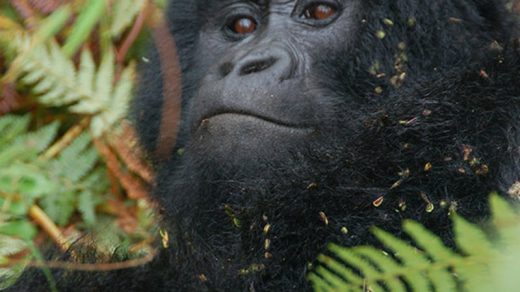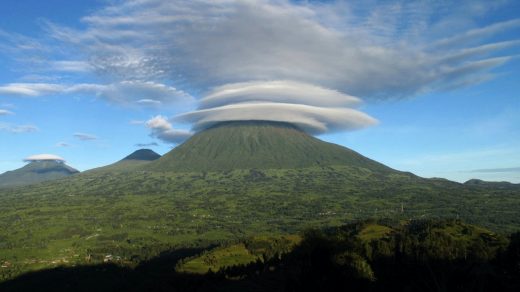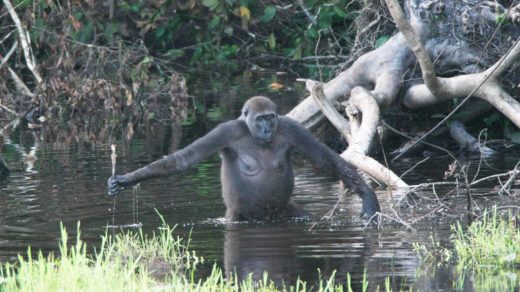The Bwindi Impenetrable National Park (BINP) in south-western Uganda is home to mountain gorillas (Gorilla beringei beringei). At the 2019 Gorilla Census (Gorilla Fund), 459 mountain gorillas lived in the park, which meant that roughly half of the world´s known mountain gorillas lived there. Colobus monkeys and chimpanzees also live in the park.
14 mountain gorilla groups in BINP are habituated to human presence, and visited by eco tourists and researchers, under the management of the Uganda Wildlife Authority.
BINP is covered in both montane and lowland forest. Is is home to over one thousand flowering plant species, including over one hundred species of ferns and 160+ species of trees.
The park is a United Nations Educational, Scientific and Cultural Organization-designated World Heritage Site.
Where is BINP?
Location: Kanungu District, Uganda
Coordinates: 01°01′S 29°41′E
Nearest city: Kanungu
The Bwindi Impenetrable National Park (BINP) is a part of the Bwindi Impenetrable Forest in south-western Uganda. This forest is located on the edge of the Albertine Rift, which is the western branch of the East African Rift.
BINP is close to the border separating Uganda from the Democratic Republic of the Congo (DRC). On the other side of the border, in DRC, we find the Virunga National Park. BINP is thus a part of a larger forested environment.
How big is BINP?
The Bwindi Impenetrable National Park (BINP) is 321 square kilometres.
Fauna
Examples of different types of animals reported from within the park:
-
120 species of mammals
-
348 species of birds
-
220 species of butterflies
Mountain gorillas in the park
At the 2019 Gorilla Census (Gorilla Fund), 459 mountain gorillas (Gorilla beringei beringei) lived in BINP, which meant that roughly half of the world´s known mountain gorillas lived in this national park. The rest of the wild mountain gorillas live in the same region; in the nearby Virunga Mountains.
14 mountain gorilla groups in BINP are habituated to human presence, and visited by eco tourists and researchers, under the management of the Uganda Wildlife Authority.
The mountain gorillas living in BINP are less well-researched than the ones living in the nearby Virunga National Park, so what we think we know about them might change in the future as more research data become available. Preliminary research carried out by Professor Craig Stanford of the University of Southern California indicate that the Bwindi population of mountain gorillas seems to have a diet containing significantly more fruit than the Virunga population. During parts of the year, the Bwindi gorillas stick to a diet that is actually very similar to that of the Bwindi chimpanzees.
Professor Stanford also noted that Bwindi gorillas travel longer distances per day than their Virunga counterparts, especially on days when they feed chiefly on fruit rather than more fibrous foods.
He also noted that Bwindi gorillas are more prone to climbing trees to feed on foliage, fruits and epiphytes, and this is true even for silverbacks. Bwindi gorillas also seem to be more fond of building their nests in trees or shrubs instead of on the ground. Their preferred species is Alchornea floribunda, a tree locally known as Echizoqwa. It is a straggly shrub that grows into a bush or understory tree, about 4.5 metres tall at most.
Development
Circa 300 mountain gorillas was estimated to live in BINP in 1997. By 2002, that number had rose to 320 individuals, and by 2006 the number was 340. With 459 mountain gorillas living in the park as of 2019, the trend is definitely going in the right direction, but the population is still vulnerable.
Threats
The main threats against the mountain gorillas in BINP are illegal hunting, disease and habitat destruction.
Gorilla tourism
Tourists wishing to track gorillas must obtain a special permit from the Uganda Wildlife Authority. Several tour companies work with the Uganda Wildlife Authority and can reserve tracking permits for visitors.
The number of visitors is limited, in order to protect the gorillas and their habitat. There are strict rules which must be adhered to, e.g. in order to prevent transmission of pathogens. Only the selected gorilla groups which have been habituated to human presence are tracked.
BINP is open for tourists year round, but accessing the park is easier during the dry season so that is peak-season for tourism. The roads are in poor conditions, and many of the eco tourist experiences, including gorilla tracking, will involve hiking on foot in fairly difficult terrains.
Accomodations include a lodge, tented camps, and rooms run by the community located near the Buhoma entrance gate.


